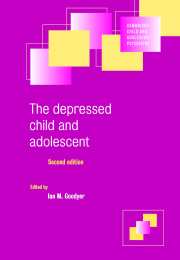Crossref Citations
This Book has been
cited by the following publications. This list is generated based on data provided by Crossref.
Remschmidt, H.
2004.
Therapie der Krankheiten im Kindes- und Jugendalter.
p.
1764.
Remschmidt, H.
2004.
Therapie der Krankheiten im Kindes- und Jugendalter.
p.
1803.
Remschmidt, H.
2004.
Therapie der Krankheiten im Kindes- und Jugendalter.
p.
1739.
Groen, G.
Pössel, P.
and
Petermann, F.
2004.
Entwicklungswissenschaft.
p.
437.
Remschmidt, H.
2004.
Therapie der Krankheiten im Kindes- und Jugendalter.
p.
1778.
Remschmidt, H.
2004.
Therapie der Krankheiten im Kindes- und Jugendalter.
p.
1821.
Remschmidt, H.
2004.
Therapie der Krankheiten im Kindes- und Jugendalter.
p.
1760.
Remschmidt, H.
2004.
Therapie der Krankheiten im Kindes- und Jugendalter.
p.
1825.
Haby, Michelle M.
Tonge, Bruce
Littlefield, Lyn
Carter, Rob
and
Vos, Theo
2004.
Cost-Effectiveness of Cognitive Behavioural Therapy and Selective Serotonin Reuptake Inhibitors for Major Depression in Children and Adolescents.
Australian & New Zealand Journal of Psychiatry,
Vol. 38,
Issue. 8,
p.
579.
Remschmidt, H.
2004.
Therapie der Krankheiten im Kindes- und Jugendalter.
p.
1829.
Remschmidt, H.
2004.
Therapie der Krankheiten im Kindes- und Jugendalter.
p.
1790.
Haby, Michelle M.
Tonge, Bruce
Littlefield, Lyn
Carter, Rob
and
Vos, Theo
2004.
Cost-Effectiveness of Cognitive Behavioural Therapy and Selective Serotonin Reuptake Inhibitors for Major Depression in Children and Adolescents.
Australian & New Zealand Journal of Psychiatry,
Vol. 38,
Issue. 8,
p.
579.
Remschmidt, H.
2004.
Therapie der Krankheiten im Kindes- und Jugendalter.
p.
1812.
Muris, Peter
and
Ollendick, Thomas H.
2005.
The Role of Temperament in the Etiology of Child Psychopathology.
Clinical Child and Family Psychology Review,
Vol. 8,
Issue. 4,
p.
271.
2006.
Family Therapy.
p.
581.
Muller, Nicole
ten Kate, Coriene
and
Eurelings-Bontekoe, Liesbeth
2007.
Handboek Persoonlijkheidspathologie.
p.
63.
Remschmidt, H.
2007.
Therapie der Krankheiten im Kindes- und Jugendalter.
p.
1878.
Remschmidt, H.
2007.
Pädiatrie.
p.
1613.
Wang, Yuan-Pang
Lederman, Luciana Pajecki
Andrade, Laura Helena
and
Gorenstein, Clarice
2008.
Symptomatic expression of depression among Jewish adolescents: effects of gender and age.
Social Psychiatry and Psychiatric Epidemiology,
Vol. 43,
Issue. 1,
p.
79.
Muller, Nicole
ten Kate, Coriene
and
Eurelings-Bontekoe, Liesbeth
2009.
Handboek persoonlijkheidspathologie.
p.
63.





